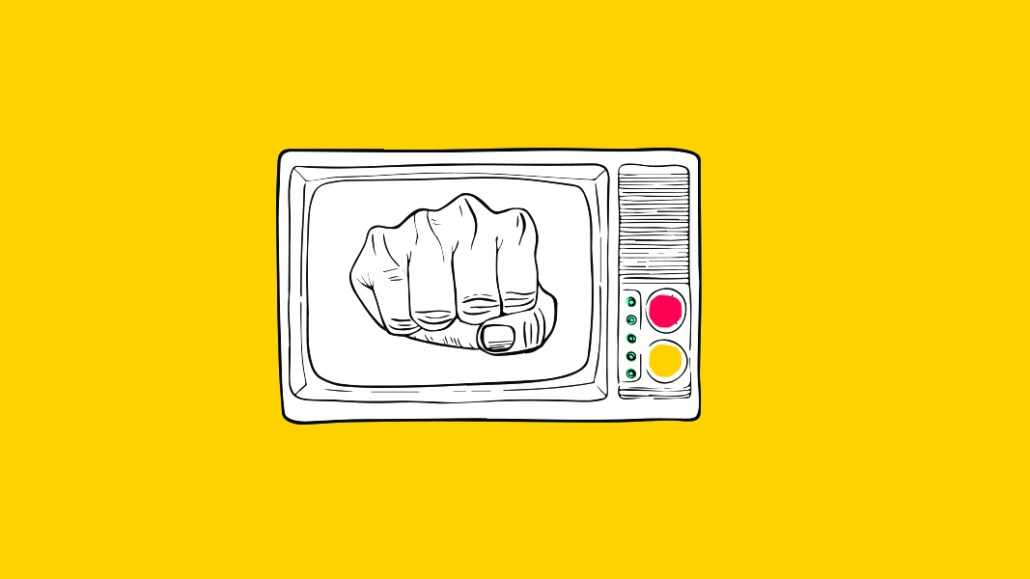Agency execs shine a light on connected TV advertising’s Goldilocks paradox during Digiday’s CTV virtual forum

Connected TV combines the best of traditional TV and digital for advertisers. At least, that’s the promise of CTV. In practice, the hybridization of TV and digital in CTV is more complicated due to nuances introduced by that blend that, when not accounted for, can compromise CTV’s promise.
This Goldilocks paradox of CTV was a focal point during the “Virtual Forum: Shaping CTV Creative Management and Measurement in 2022” event that Digiday hosted on June 7.
“CTV sort of lives in that middle ground, that Goldilocks world, and I think some advertisers may bring to it their legacy biases and their particular bent on things,” Nathan Hugenberger, CTO and evp of science at Known, said during a session on balance between brand and performance advertising on CTV.
Embracing too extreme of a traditional TV strategy; Adopting too much of a digital strategy; Underestimating the costs associated with granular targeting and measurement on CTV.
The fact that both traditional TV advertisers and digital-native advertisers alike can apply their respective legacy biases to CTV is, again, part of the promise of CTV. But one peril of this promise is advertisers adhering too strictly to those legacy strategies and not accounting for CTV’s nuances that can require adjusments in advertisers’ approaches.
“Some people are bringing to this a legacy of thinking about TV and video in a very sort of old-school television way, and some people are coming to CTV and thinking about digital and thinking about performance where they’re expecting that click and [being] easy to measure using last-touch [attribution] and very simplistic methods,” Hugenberger said.
However, the reality is not so straightforward.
For example, CTV’s digital delivery enables the kind of granular ad targeting and measurement advertisers are accustomed to on digital and find largely unavailable on traditional TV. But it’s not entirely as granular as digital.
“We are stuck with household-level exposure data,” Kathleen Metzger, vp and group director of insights and analysis at Digitas, said in a session on advanced streaming measurement. “So if there’s five people living in my house, you’re not sure if I saw [an ad] or my husband saw it or my kids saw it. The only way to get at that is following up with a survey to ask a couple questions about my consumption habits to know who in the household saw it.”
CTV being a household-level device as opposed to an individual-level one like a phone or computer isn’t a bad thing, especially for brand messaging. But it means that advertisers need to be mindful of how narrowly they aim their CTV campaigns and set appropriate expectations for the specificity of the data they receive from those campaigns.
Advertisers also need to be cognizant of the costs associated with the more granular targeting and measurement that is available for CTV campaigns. “Data costs in general can get so prohibitively expensive that it’s really left to the large brands that are able to pay for those kinds of things,” said Metzger. “I would love to see the cost of using data smartly to target on CTV go down.”
While advertisers adhering too much to their legacy strategies when advertising on CTV is one potential pitfall, another is advertisers taking too much of a departure from their legacy strategy with CTV. That can take the form of traditional TV advertisers adopting too much of a digital approach on CTV or digital-native advertisers embracing too extreme of a traditional TV strategy on the internet-connected screen.
For example, Publicis Media has had a client that is a heavy TV advertiser and has moved “a significant amount of dollars into CTV,” Nicole Whitesel, evp of advanced TV and client success at Publicis Media, said in a session that covered the efficiencies and inefficiencies of CTV. “And as part of that, they want to apply every measurement, every tag, every kind of outcome-based thing as well as demo verification.”
On the other end of the spectrum, Whitesel said she has seen direct-to-consumer marketers that have historically advertised on platforms like Facebook shift some of their spending toward CTV to build their brands and, in the process, assume that they cannot take what they’ve been doing on the digital platforms and do it on CTV “because I’m not going to get the outcomes that I need for the growth that’s so critical for the future of my business.”
“It’s just funny that you would inherently think it’s probably going to be the opposite: that a TV brand would make CTV or streaming more like TV and that digital-native brands will probably make streaming more like TV. And they’re primarily doing the opposite in a lot of cases,” said Whitesel.
More in Future of TV

‘A year of loose ends’: Digiday editors share top takeaways from 2025
This year was filled with major developments – from Netflix’s planned WBD deal to Omnicom’s acquisition of IPG to Google’s ultimately cookie reversal – and Digiday editors Sara Jerde and Seb Joseph help to recap the year that was (and wasn’t).

Future of TV Briefing: How the future of TV shaped up in 2025
This week’s Future of TV Briefing looks back at the top topics and trends that overtook the TV, streaming and digital video industries in 2025.

Programmatic agency execs speak out on CTV transparency
At the recent Digiday Programmatic Marketing Summit, agency executives spoke out — on stage and in behind-closed-door town hall sessions — on how they see transparency in CTV.








